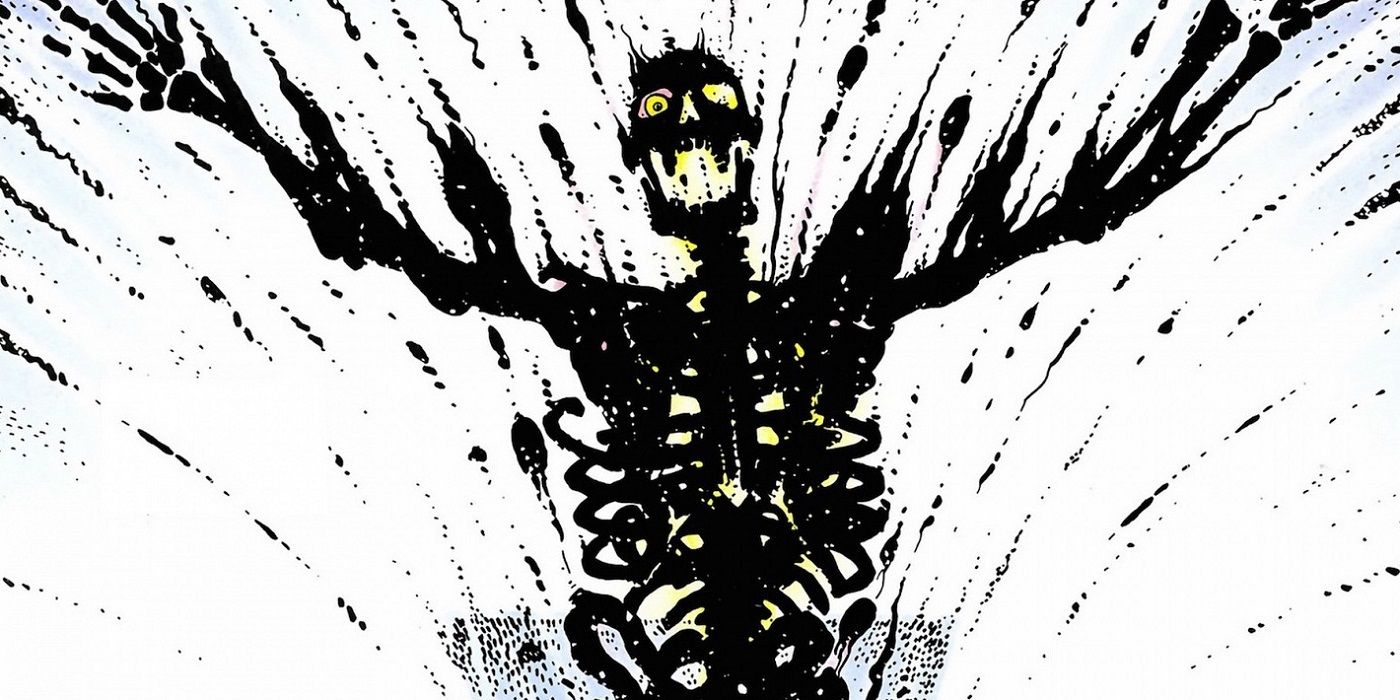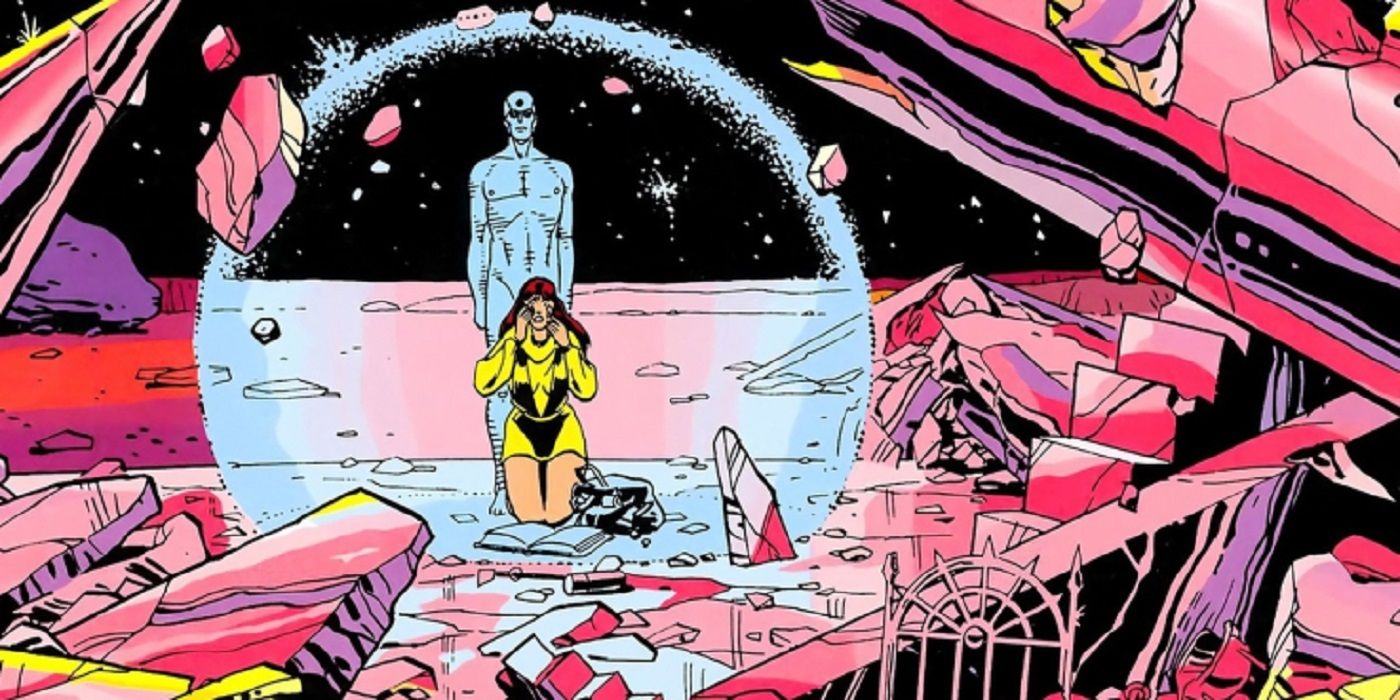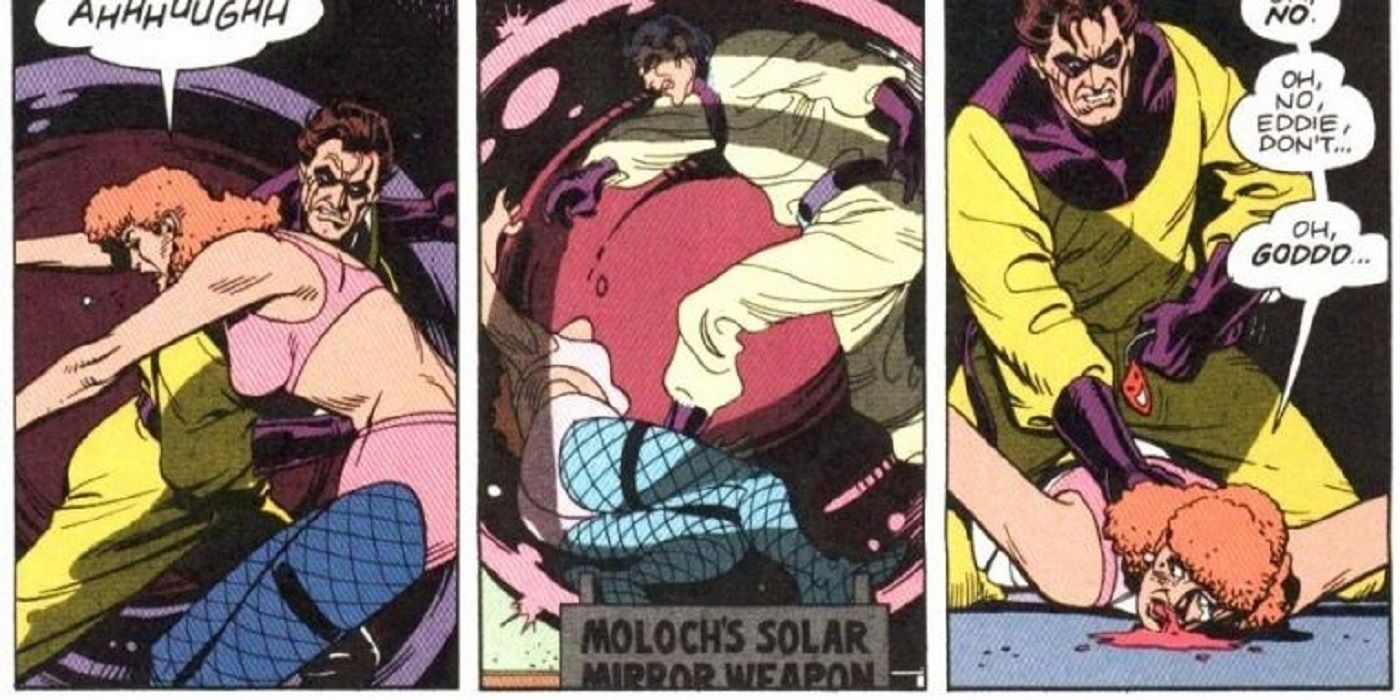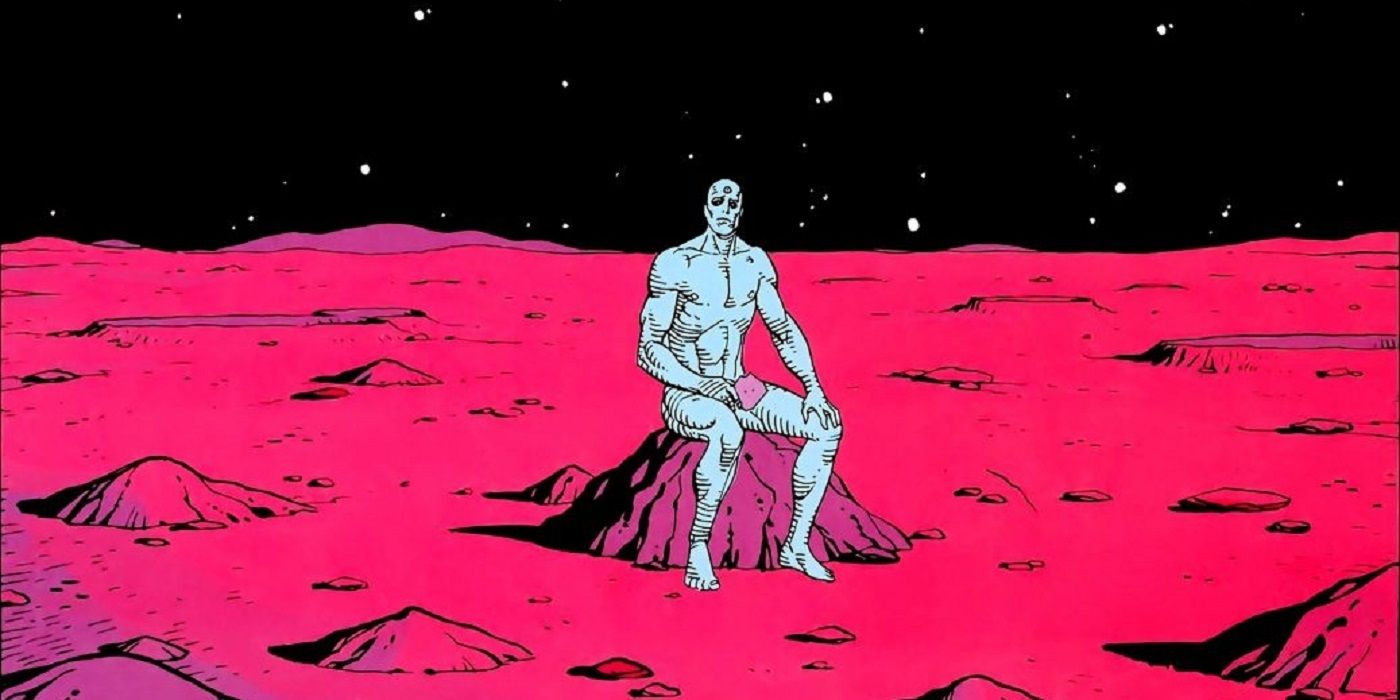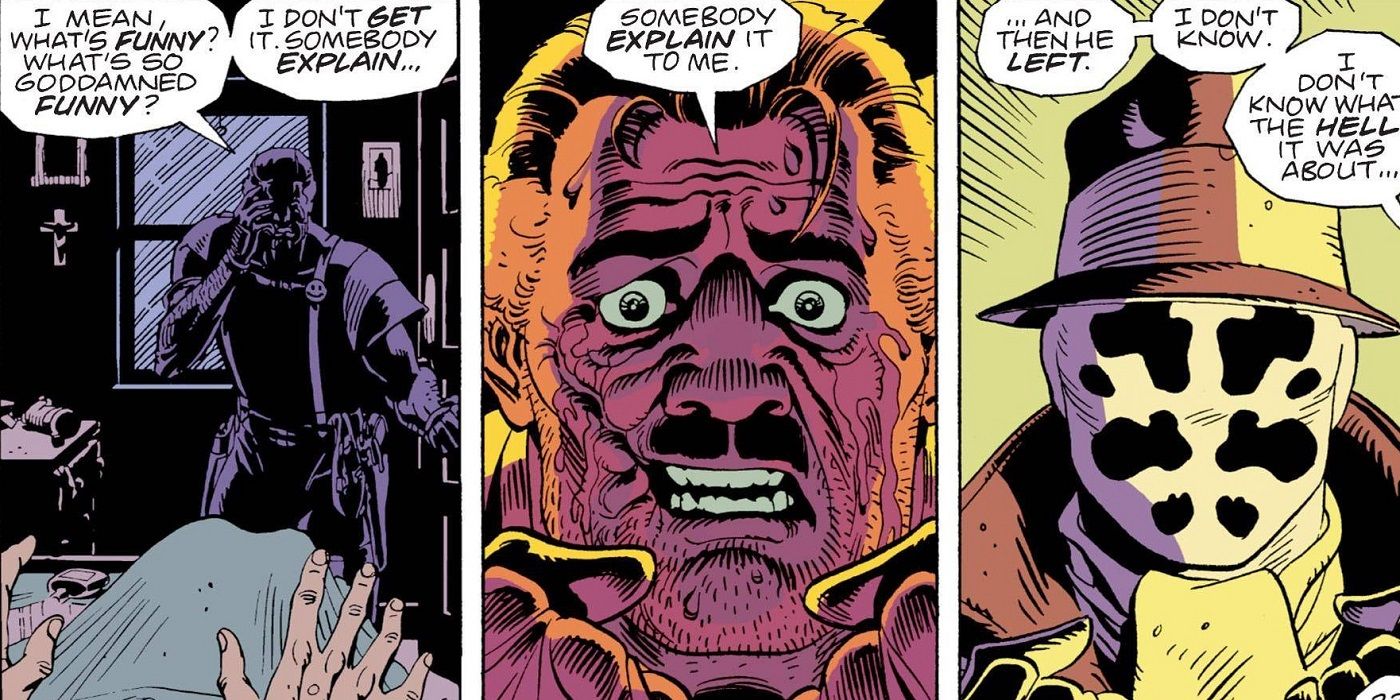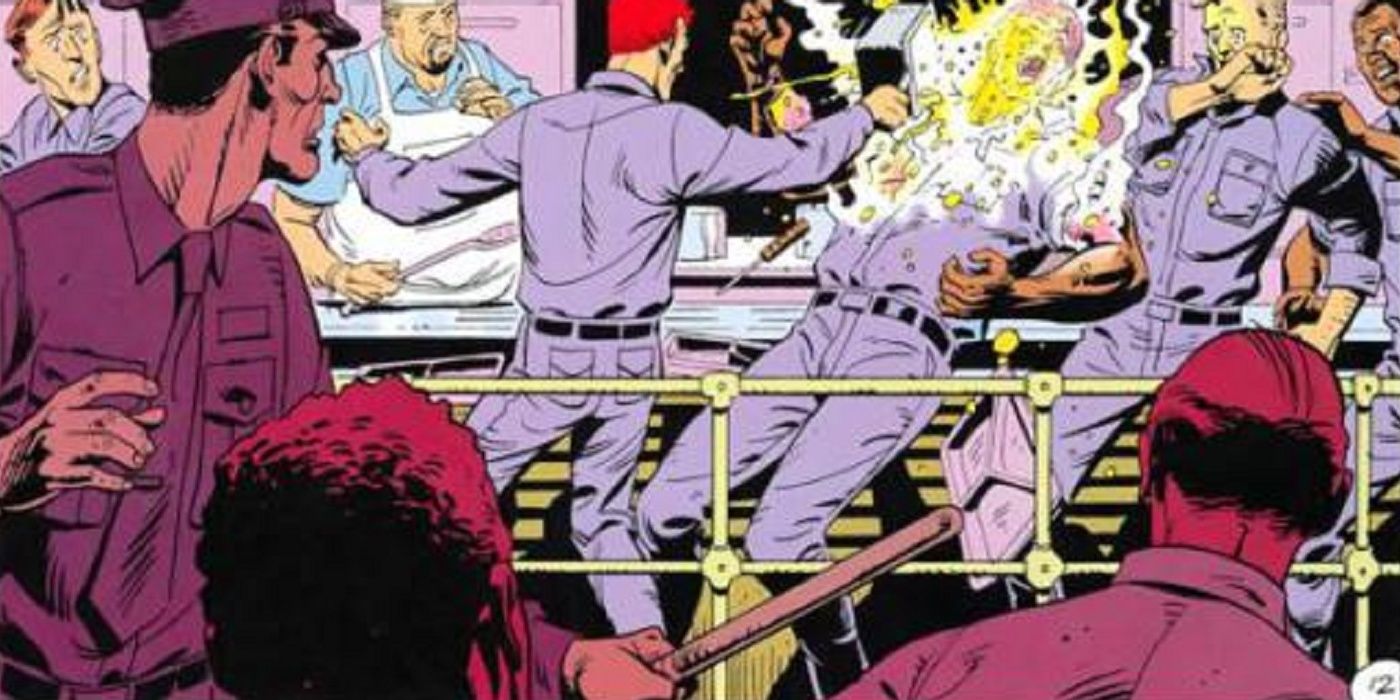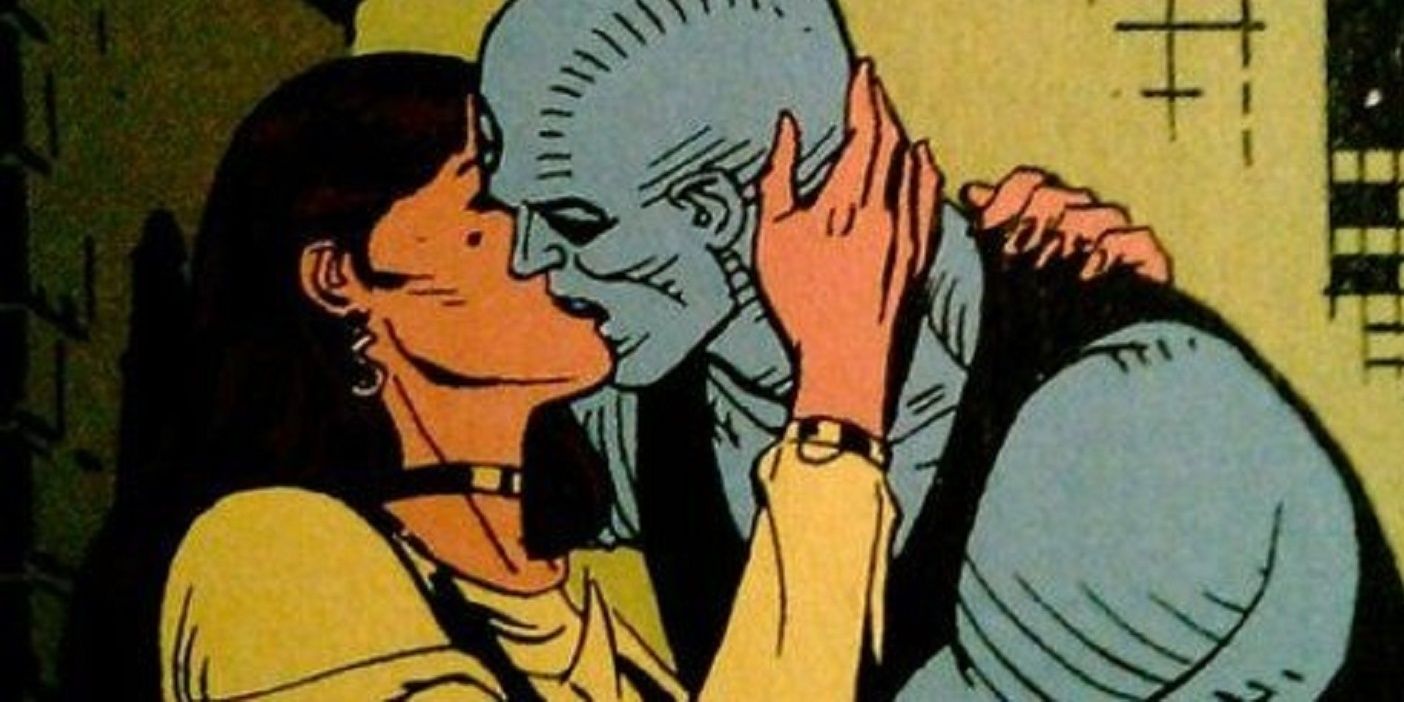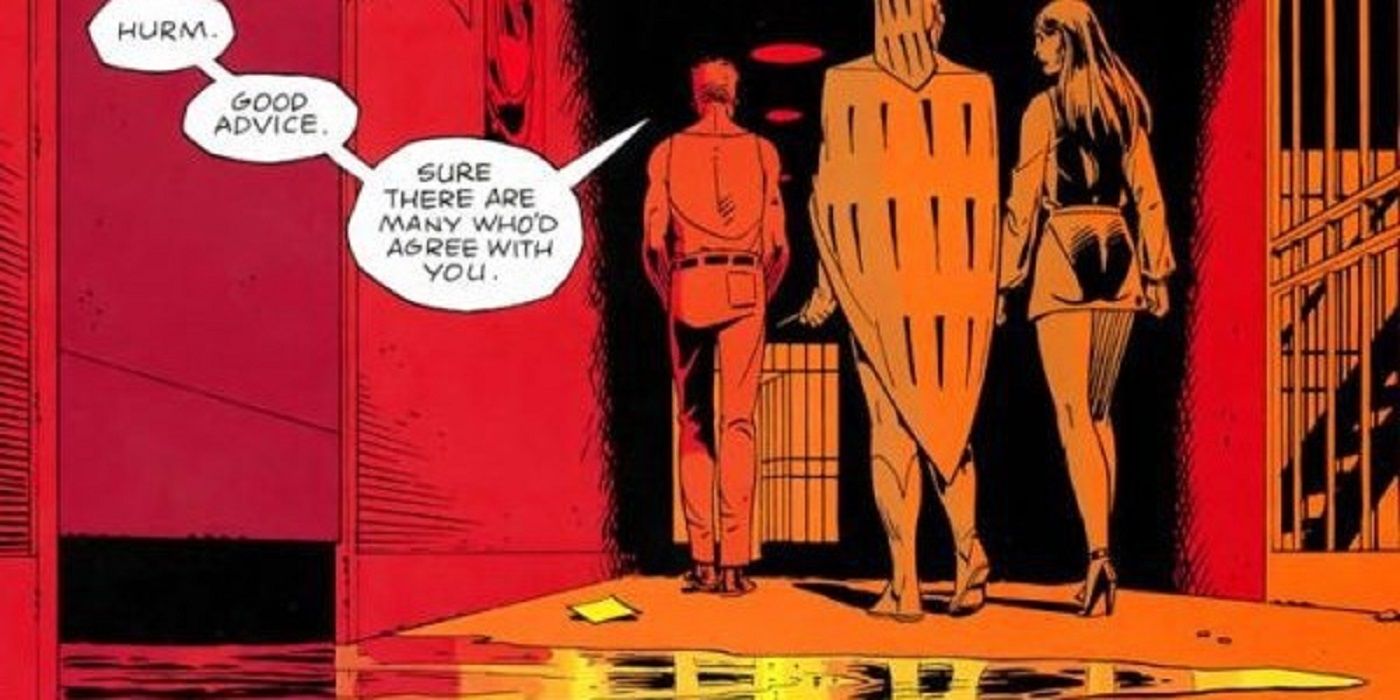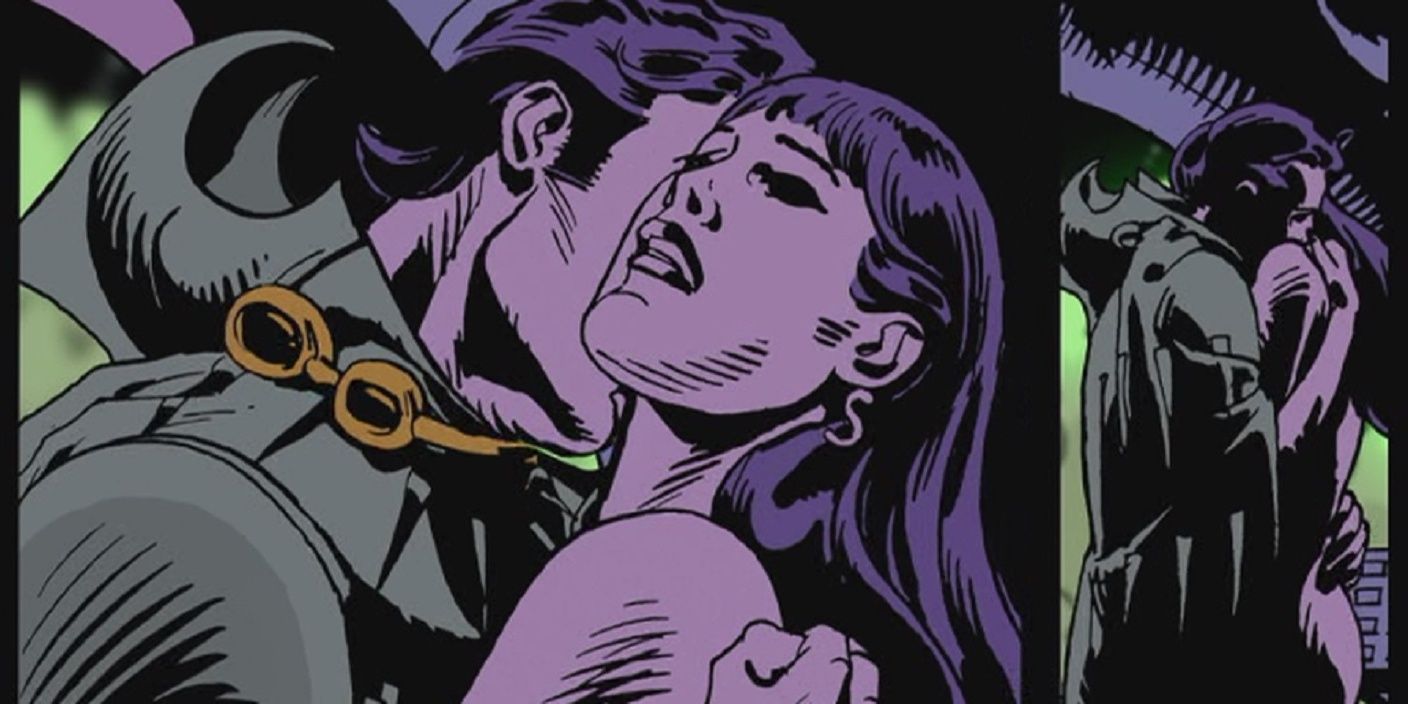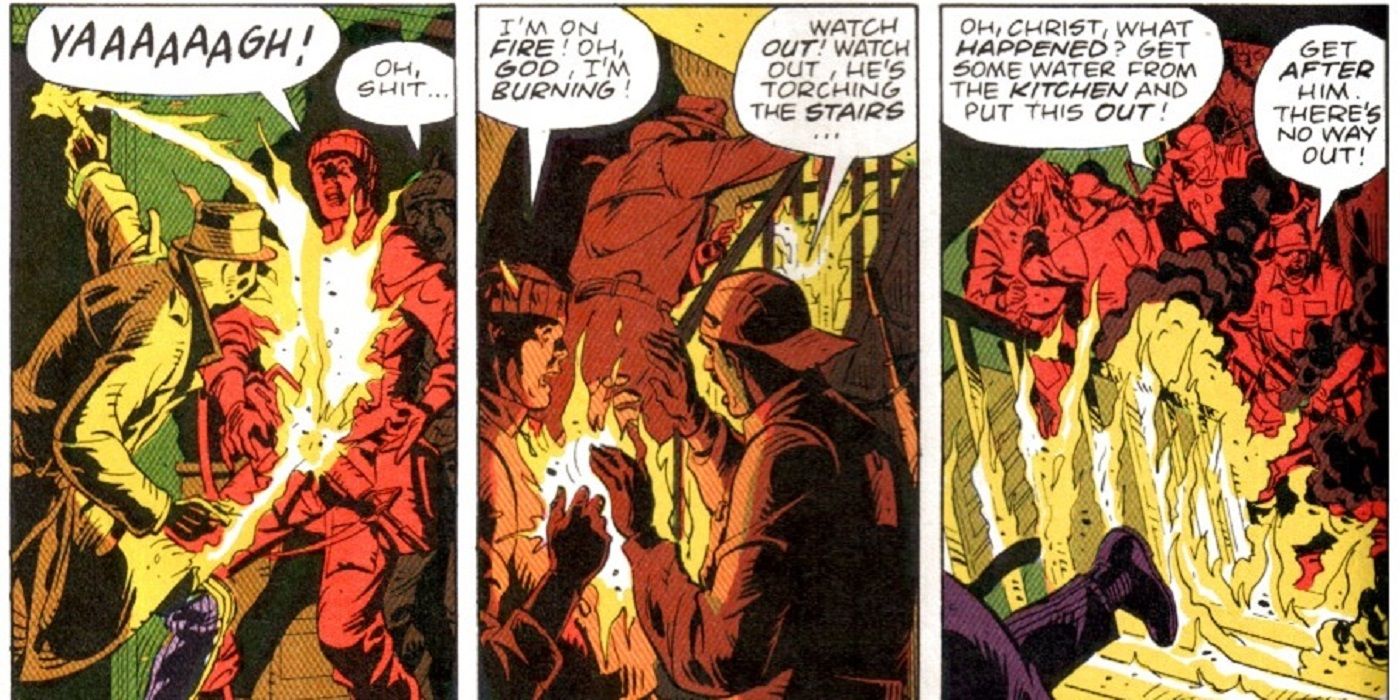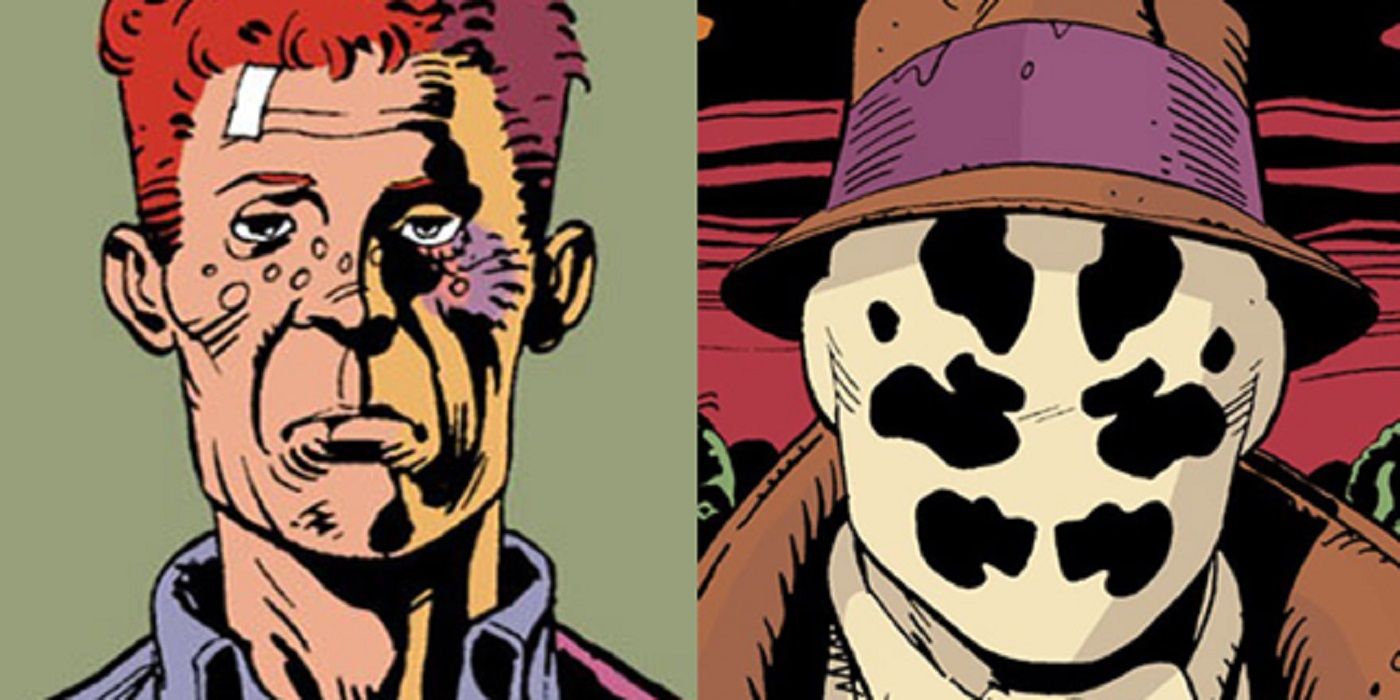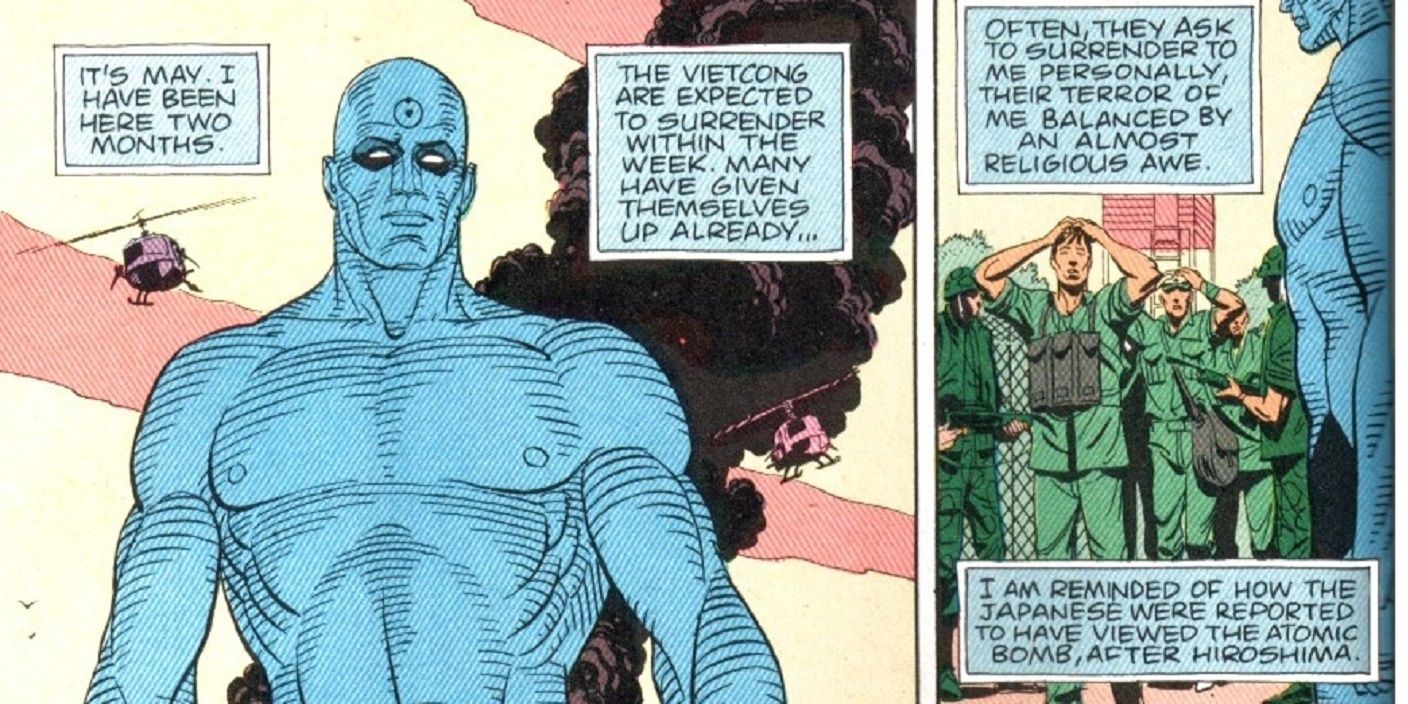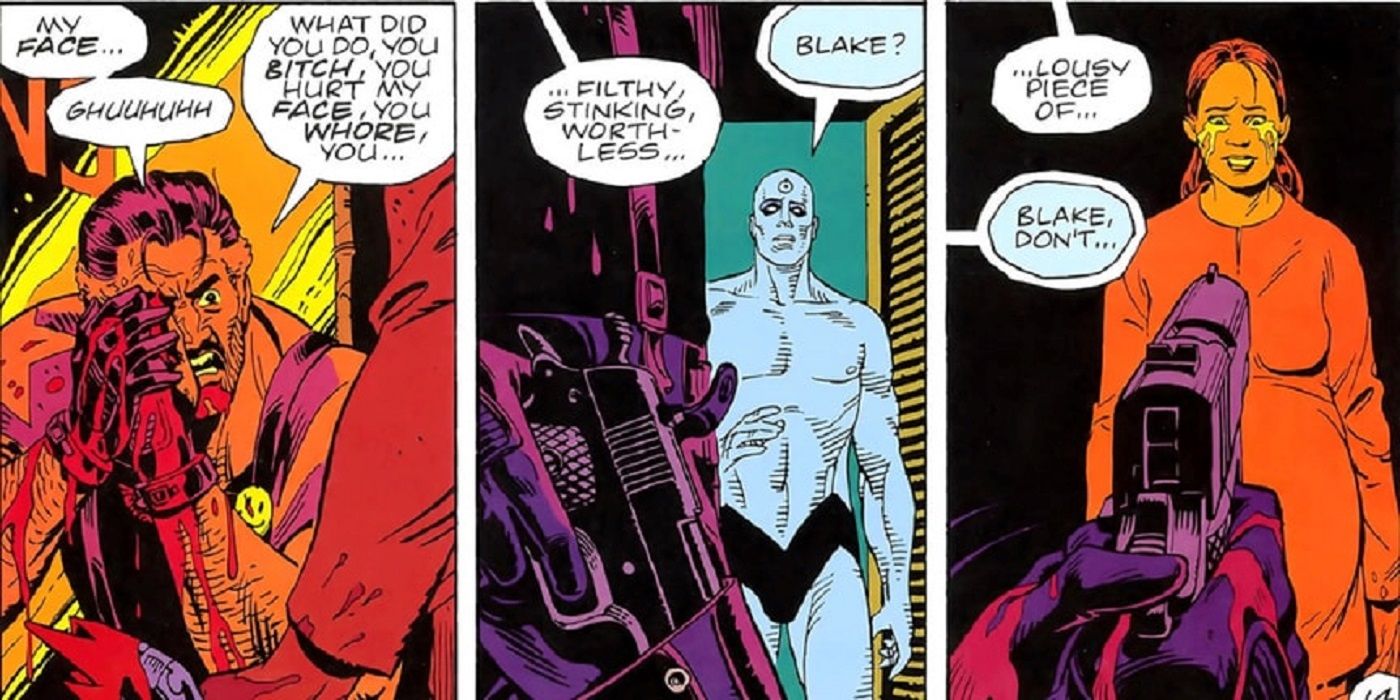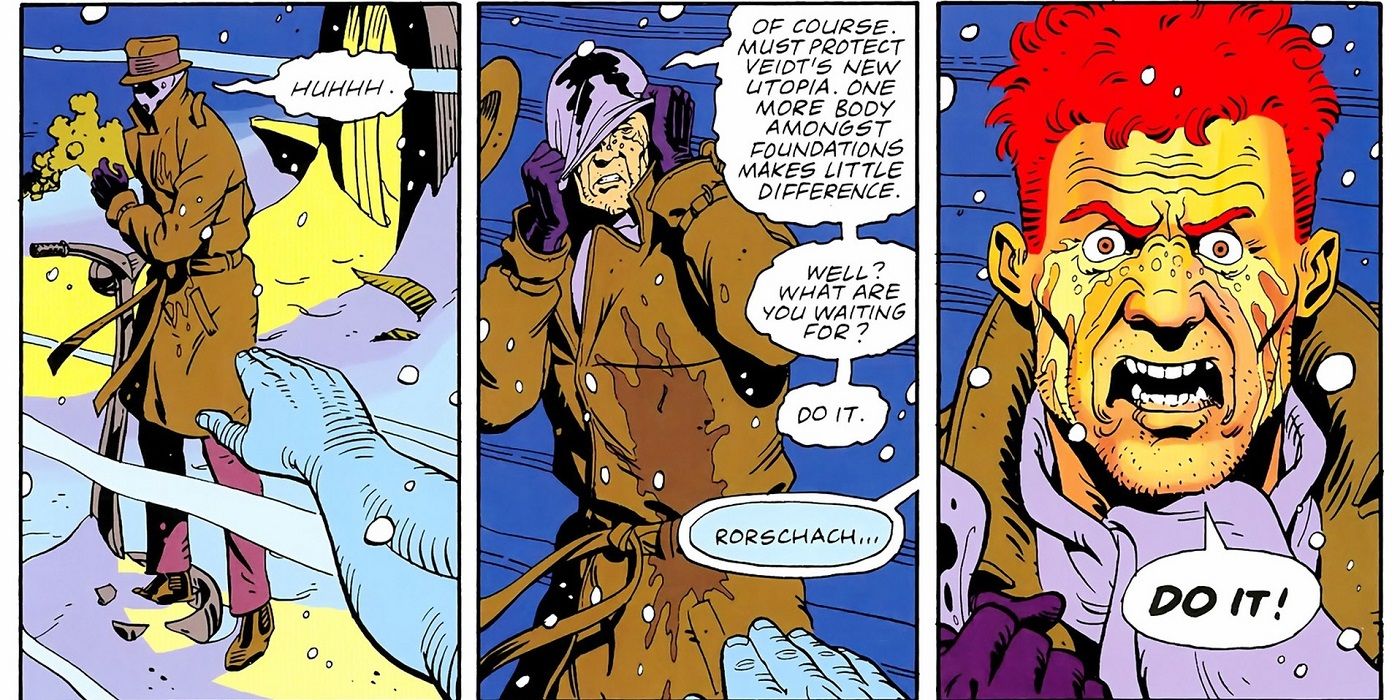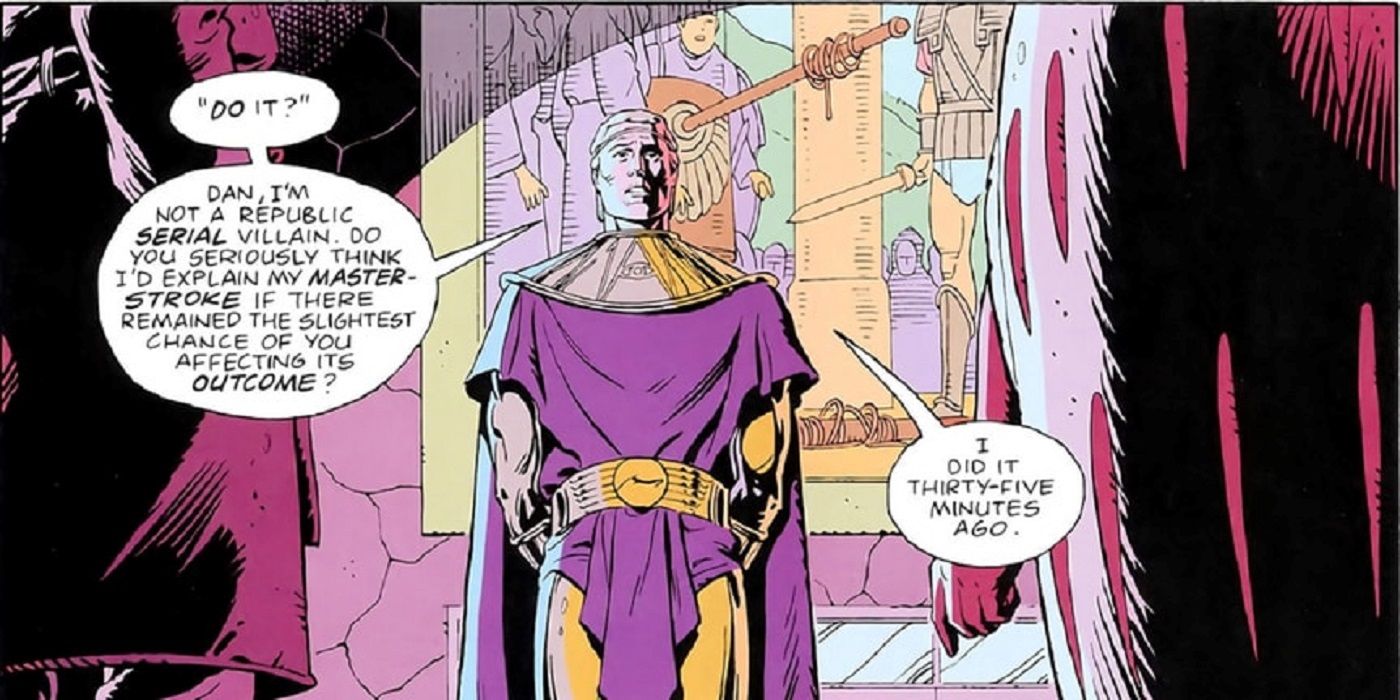Geoff Johns brought in 2017 with a bang after tweeting his intention to write a “Rebirth” follow-up utilizing characters from Alan Moore and Dave Gibbons’ “Watchmen.” Though this wasn’t a complete surprise, given the shocking finale of “DC: Rebirth” #1, which hinted Dr. Manhattan was somehow responsible for constructing the New 52, some fans feel another “Watchmen” revival is tactless, citing Moore’s ongoing battles with DC. Then again, when has Johns ever been afraid of controversy?
RELATED: The 15 Best Hidden Treasures in Watchmen
Love him or hate him, it’s fair to say Johns faces a formidable challenge taking on the “Watchmen” mantle. It’s cram-packed with shocks, thrills and complex characters that blur the lines between hero and villain. To celebrate all that’s great about “Watchmen,” CBR has compiled a list of the most shocking moments from the series. But be warned: if you gaze into the abyss, the abyss gazes also into you…
15 WHO’S YOUR DADDY
When Laurie Juspeczyk is transported to Mars by Dr. Manhattan to save her from impending nuclear war in “Watchmen” #9, she tries to convince her super-powered ex to return to Earth and save humankind instead. Against all odds, she manages this incredible feat, but only after reaching a shocking self-realization: her father is not the Hooded Justice as she always believed, but The Comedian, the despicable anti-hero who once attacked her mother (more on that later).
Understandably, this shocking revelation rocks Laurie to the core, as it did the comic book community upon release. The Comedian has few redeeming features and Laurie never saw him as anything other than a villain; however, once she’s forced to accept she would not exist without him, she realizes how much she has distorted her memories to suppress the truth of who she really is.
Though it’s highly controversial to make Laurie the product of such a dysfunctional relationship, Dr. Manhattan’s decision to help mankind becomes all the more poignant for it. It’s not only a pivotal moment in the narrative, but one of the most beautiful and moving sequences Moore and Gibbons ever put together.
14 THE COMEDIAN'S ASSAULT
Of all the shocking moments in this series, the flashback of Edward Blake’s violent assault of Sally Jupiter in “Watchmen” #2 is perhaps the most widely recognized. After trying to kiss Sally and receiving a “no thanks” in the form of a sharp right hook to the jaw, Blake persists trying to force himself on his teammate, striking her repeatedly as she tries to resist. Although Hooded Justice steps in at the last minute to save Sally, Blake makes it clear he feels no remorse. Ever the Comedian, he tries to turn the whole thing into a joke about Hooded Justice getting off on violence.
What makes this sequence so disturbing is not simply that a supposed hero could do something so vile -- although that’s a big part of it -- but the fact that Blake escapes punishment, as Sally decides not to press charges in case it damages the Minutemen’s credibility. It’s through moments like these that Moore and Gibbons really get under the skin of readers: between The Comedian’s moral bankruptcy and the Minutemen’s inability to exact justice, you can’t help but wonder… what’s the point of being a superhero if you can’t even stop your own team from becoming monsters?
13 THE MELTDOWN OF DR. MANHATTAN
When Jon Osterman appears on a live TV Q&A session in “Watchmen” #3, he doesn’t anticipate questions about whether being nuclear-powered isn’t such a good thing. When a reporter queries whether Dr. Manhattan caused people close to him (including his ex-girlfriend Janey Slater, his “buddy” Wally Weaver and the once-villainous Moloch) to develop cancer… well, let’s just say he reacts badly. And by badly, we mean he teleports all the people in the studio to a nearby parking lot in a hissy-fit before vanishing off to Mars to sulk.
This sequence is shocking for a number of reasons, not least because Manhattan’s extraordinary powers are supposed to be balanced by his cold and calculating intelligence. Through this emotional outburst, Moore and Gibbons remind the reader that Osterman is still human and therefore fallible, raising difficult questions about how much power man can safely possess -- a politically significant point, given the origin of Manhattan’s abilities.
Oh, and did we mention his tantrum also heats up the Cold War? Just in case you missed that last political statement about the dangers of nuclear power, Moore and Gibbons really drive it home as Manhattan’s departure prompts the Russian invasion of Afghanistan… and all because someone asked an uncomfortable question.
12 THE BREAKDOWN OF THE COMEDIAN
“Watchmen” #2 reflects on various events during The Comedian’s life, but arguably one of the most unnerving is also one of few that gives Edward Blake some semblance of humanity. As he sits at the bedside of his former nemesis, Moloch, pouring out his heart and soul to a man who was once his enemy, he pleads for “somebody [to] please explain it.”
Of course, it’s really Blake who is explaining to the reader what is to come: his drunken monologue and theories about a conspiracy to incite the wrath of God (read: Dr. Manhattan) foreshadow nearly every element and theme of the greater plot of the “Watchmen” series, making it one of those scenes that demands to be revisited.
None of that makes feeling sorry for a scumbag like Blake any less uncomfortable… but that’s the beauty of it. By juxtaposing Blake’s emotional vulnerability with his many acts of brutality and violence, Moore and Gibbons give us an unflinching portrayal of an extremely complex character who is at once heroic, villainous and incapable of saving himself. If that’s not a shocking subversion of the superhero genre, we don’t know what is!
11 RORSCHACH OILS UP A PRISON INMATE
If Walter Kovacs’ time in prison taught us one thing, it’s that he isn’t great at making new friends. Pretty much everyone else Rorschach meets within the prison’s walls threatens to kill him -- he was once a superhero, after all, and is directly responsible for putting some of them away! Luckily, Rorschach finds a rather unique way of warming up this frosty reception in “Watchmen” #6.
After fellow inmate Otis holds a shiv (a makeshift knife, to those not fluent in prison lingo) to his back, Kovacs retaliates by throwing a canister of boiling oil in his enemy’s face, leaving him with extensive third-degree burns. As he’s dragged off to solitary confinement, Rorschach screams a warning to anyone else thinking of trying to take him out: “I’m not locked up in here with you. You’re locked up in here with me!”
This sequence is a chilling reminder that while Rorschach may be one of the good guys, he’s not necessarily a good guy… meaning he’s not bound by the same moral code as the average superhero. He can fight just as dirty as his opponents and isn’t afraid to take out the trash.
10 DR. MANHATTAN TRADES UP FOR A YOUNGER MODEL
After Jon Osterman is transformed into Dr. Manhattan, he grows increasingly distanced from his humanity and plays the role of cold and detached demigod, keeping the world in balance from on high. So much so, in fact, that Sally Jupiter compares him to an H-Bomb, with one vital difference: the American government “didn’t have to get the H-bomb laid every once in a while.”
Yup, that’s right, ol’ Manhattan’s got a wandering eye… and as it turns out, his tastes aren’t all that different from your average red-blooded heterosexual male. Perhaps the most shocking demonstration of this is when Osterman decides to pursue Laurie Juspeczyk, despite her only being 16-years-old when they first meet in “Watchmen” #4 and him having a long-term partner at the time.
By pairing Manhattan with a girl that is barely of legal age in much of the West and making him a cheat, Moore and Gibbons manage to morally compromise their hero and make a cutting observation of modern sexuality in one fell swoop. This is one of those truths that cuts a little too close to the bone, but that’s part of what makes this series so special.
9 RORSCHACH'S REVENGE, PRISON-STYLE
You know you’ve got good friends when they’re willing to break you out of prison -- but as noted earlier, Rorschach doesn’t really have much use for friends. After Nite Owl and Silk Spectre scale the walls of the prison intent on pulling off a daring escape in “Watchmen” #8, they find that the man they've come to save has already freed himself from his cell with a very different goal in mind… the killing of the villain, Big Figure.
What’s so scary about this sequence isn’t that a hero would be prepared to kill his nemesis (we’ve seen heroes kill before), but Rorschach’s nonchalant attitude towards the murder. Coolly informing his teammates that he needs to “visit the men’s room," Rorschach follows Big Figure inside as if it’s the most normal thing in the world. When he emerges a few moments later accompanied by a trickle of blood on the floor, and is scolded by Laurie for “div[ing] headfirst into things,” he retorts that he’s sure many would agree with her… implying Big Figure just took a dive in the nearest toilet bowl. Again, Moore and Gibbons skilfully subvert readers’ expectations regarding how a hero should think, act and fight.
8 NITE OWL'S UNUSUAL APHRODISIAC
One of the most interesting -- and controversial -- questions that Moore and Gibbons pose in this series is why people with no superpowers to speak of would feel compelled to go out night after night, fighting crime, kitted out in lurid-colored spandex, face masks and utility belts. The answer offered in “Watchmen” #7 is a real eye-opener for anyone who assumes superheroes are doing it for the greater good.
After his bedroom antics with Laurie are a flop (and, yes, that pun is very much intended), a mortified Dan Drieberg flees to the one place that doesn’t make him feel inadequate -- his Nite Owl workshop -- and impulsively decides to get his mojo back by coming out of crime-fighting retirement. Saving a few civilians from a burning building finally seems to do the trick for Nite Owl, who manages to heat things up with Silk Spectre in his aircraft. Who knew being a superhero would be so sleazy.
All jokes aside, this sequence is a masterstroke by Moore and Gibbons, despite being supremely icky (or perhaps because of it): Nite Owl’s sexual impotence and self-loathing form a stark and shocking contrast against traditional depictions of Alpha Male heroes whose self-assured masculinity is routinely enforced.
7 RORSCHACH ROASTS A COP
As part of his investigation into who killed The Comedian and why, Rorschach reaches out to some rather unexpected sources and is quick to respond when he receives word that the former villain Moloch has information that might be helpful. However, it soon becomes clear in “Watchmen” #5 that Rorschach has walked directly into a trap: Moloch is dead and someone’s already called the cops.
To say Rorschach fights dirty in his attempt to escape this carefully calculated frame-up is an understatement. In one of the most shocking sequences ever seen in Moore and Gibbons’ series, he goes so far as to douse one officer in Veidt hairspray before setting him (along with most of the stairwell they’re in) alight. Fighting villains using underhanded tactics is one thing, but a cop?! That’s a whole other ball game.
This is another great example of how Moore and Gibbons have totally torn up the superhero rulebook, showing how vigilantes like Rorschach don’t only operate outside the law -- they treat it (and, by extension, the people enforcing it) like the enemy. They don’t answer to anybody, and anyone unfortunate to get in their way is toast… or, rather, flambé!
6 THE BIRTH OF DR. MANHATTAN
There’s no doubt that Dr. Manhattan is an imposing and rather unsettling figure, given his baffling array of quantum-based powers and his godlike relationship with the rest of humankind. But it’s not until “Watchmen” #4 that the full, terrifying extent of his transformation is revealed.
In an origin story echoing that of other nuclear-themed characters such as Captain Atom, Firestorm and the Hulk, Jon Osterman finds himself trapped in an experimental device that quite literally strips him down to the bone… and waaaay beyond. In the jaw-dropping visuals that follow, readers are given a front-row seat to his dematerialization and gradual reassembly, ending with him fully-formed, bright blue, butt-naked and floating unsupported in the air.
It’s a frightening and bizarre sequence, not lessened by the ghostliness of his initial appearances around the army base, but perhaps what’s most shocking about Osterman’s transformation is how the immensity of his powers profoundly alters his psyche. Moore and Gibbons manage to demonstrate the mental and emotional dissonance wrought by the change as effectively as they depict his physical alterations, to the extent that Manhattan feels as detached from his human past as it’s possible to be.
5 RORSCHACH GOES TO THE DOGS
The story of how Kovacs became Rorschach is not easy to stomach, as his clinical psychologist Malcom Long learns the hard way -- as have countless readers of Moore and Gibbons’ ground-breaking series over the years. In “Watchmen” #6, aptly titled “The Abyss Gazes Also” in a nod to Nietzsche’s infamous warning, Kovacs spills the beans about what set him on his current path… and it’s enough to drive any man mad.
It’s hard not to sympathize with Rorschach as he shares memories of his failed attempt to save a young girl from being butchered and fed to dogs, and when he coldly explains how he killed the dogs and chained the kidnapper up before burning his house to the ground, most readers cheer his rough justice. But the sort of man who stands outside a burning building making sure no one survives is not a hero: he’s a dark, uncompromising vigilante who believes the world has no meaning. He’s the sort of guy that, when you scream for him to save you, will say “NO.”
4 DR. MANHATTAN CHANGES HISTORY
Okay, so there’s been discussion in this list already about the extent of Dr. Manhattan’s powers, but we here at CBR wouldn’t be doing our jobs if we didn’t point out the most impressive (and kind of terrifying) feat that Manhattan accomplishes: he significantly changes the course of history.
The “Watchmen” series takes place in an alternate 1985, in which the U.S. has become the supreme and dominant power in the world after a number of decisive victories, including the Vietnam War. This is thanks to the awe-inspiring power of Dr. Manhattan, who many view as a supreme deity who cannot -- and should not -- be resisted. In “Watchmen” #4, readers get a glimpse of his domination firsthand as people literally fall over themselves to surrender to him personally.
Ever the political critics, Moore and Gibbons show readers that a world with Dr. Manhattan in it isn’t necessarily better or safer -- the Vietnamese people’s unconditional surrender is directly compared to the fall of the Japanese after Hiroshima. If that’s not controversial enough, Nixon’s continuing stint in office is bound to ring alarm bells. The message is clear: peace is too fragile a thing to be sustained by a single man, superhuman or not.
3 THE COMEDIAN MURDERS HIS LOVER AND CHILD
It’s fair to say The Comedian likes war a little too much. He is, as Manhattan asserts after meeting him, “deliberately amoral” and seems to take divine pleasure in the killing of his enemies. But his bloodlust and adeptness for battle pales in comparison to the most despicable deed Blake ever commits in the “Watchmen” series: the murder of a young Vietnamese girl who claims to be carrying his child.
This shocking sequence occurs in “Watchmen” #2, after the pregnant woman confronts Blake in an emotional state, fearing that he plans to leave the country with the remainder of U.S. forces and leave her child without financial support or a strong father figure to look up to. She breaks a bottle and slashes his face, and in a moment of furious retaliation, The Comedian turns a gun on her and shoots her down… all while Dr. Manhattan looks on.
It’s a harrowing turn of events that completely stains The Comedian’s character, but it also serves to reinforce Moore and Gibbons’ political commentary on the real casualties of war. It’s not a moment the CBR team will forget in a hurry, that’s for damn sure.
2 DR. MANHATTAN MURDERS RORSCHACH
There aren’t many writers who could make readers not only sympathize with, but also actively root for, a character as deranged and anti-social as Rorschach, but it’s something Moore and Gibbons pull off without a hitch. And while that makes for an excellent comic series, it only makes the death of such a complex and beloved character all the harder to handle.
In the climactic scenes of “Watchmen” #12, after Rorschach comes to blows with Dr. Manhattan over what should be done to put an end to Ozymandias’ siege of terror on Manhattan (don’t worry, we’ll get to that in a moment), readers see Kovacs unmasked and reduced to tears, but still willing to die rather than compromise in the face of evil. His unflinching commitment to his own ideal and desperation in these final moments is enough to affect the hardest soul, but that’s not the only reason Rorschach’s death places so highly on this list. The most shocking thing about this whole sequence is that the justice he was willing to die for will probably never be enacted: Ozymandias' unspeakable crimes against humanity will likely go unanswered for, as Dr. Manhattan decides to step aside and let the worst happen. In the end, his death doesn’t change a thing.
1 OZYMANDIAS WINS
As ever, CBR has saved the best -- or more accurately, the most shocking -- until last. In “Watchmen” #11, the Minutemen finally learn that Adrian Veidt, otherwise known as Ozymandias, is the one behind The Comedian’s murder and, worse still, a plan to unleash hell on the city of Manhattan in the form of a Cthulhu-esque, pseudo space-monster.
Just when you think Moore and Gibbons are about to confirm to the supervillain trope and have the criminal mastermind spell out exactly what it’s going to take to stop him, they drop the most shocking bombshell of the series: that Ozymandias began the attack 35 minutes ago, and that there’s nothing the Minutemen can do to prevent it. The resulting carnage, laid out in detail in “Watchmen” #12, is about as gratuitous as it gets.
As shocking as this sequence is, it’s arguable that Ozymandias’ staging of a horrific alien attack on Manhattan was the best-case scenario for a world teetering on the brink of nuclear war. That, perhaps, is the most controversial element of Moore and Gibbons’ series, when you get down to it. When tentacular genocide is the best you can hope for, you know you’ve got problems.
Are there any other moments from the original 1986 series you reckon deserve a place on this list? Let us know in the comments!

